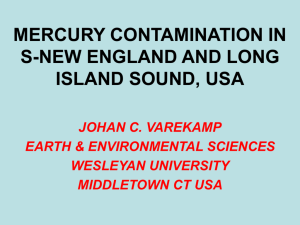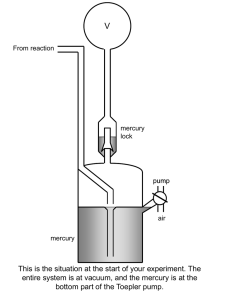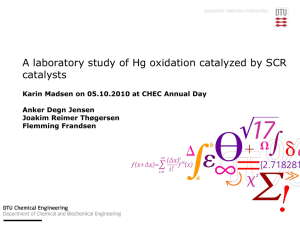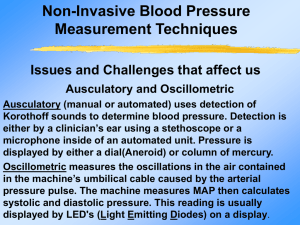Mercury66 in Soils a..
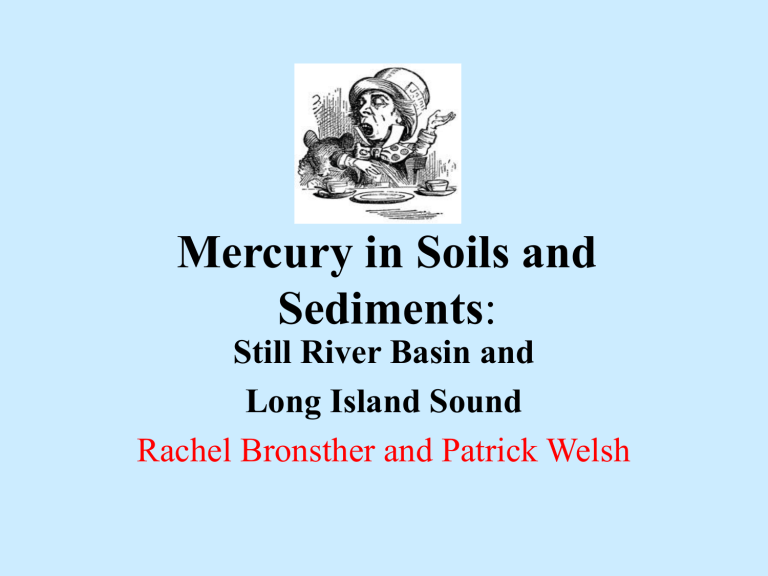
Mercury in Soils and
Sediments :
Still River Basin and
Long Island Sound
Rachel Bronsther and Patrick Welsh
Mercury (Hg)
Hg comes in elemental and various organic compounds and complexes (e.g. HgS, HgCl2, MeHg)
Exposure to organic Hg, in particular methylmercury, has potential adverse effects in humans. Exposure can be from ingestion or inhalation. The nervous system is harmed by the organic compound.
Elemental Hg can become methylated by the environment .
Low Dose Effects
In children:
Neurotoxicity (e.g. problems with fine motor skills, visual-spatial abilities, verbal memory)
In adults (long term, lose dose exposure): weakness, tiredness, headaches, lack of appetite, digestion problems, weight loss, trembling of hands, numbness of extremities, tingling of lips and tongue, etc.
Fish Consumption
EPA has determined that the primary form of human exposure to methylmercury is through fish consumption.
Population at the greatest risk – children who eat or whose mothers consume a large amount of fish
EPA has determined that a RfD of 0.1 ug MeHg/day is acceptable.
Mercury in Soils
No decisive data seems to exist on what levels in soil are “safe”.
In CT, up to 20 ppm of Hg in residential areas is acceptable.
(Compared to MA, where legal residential levels are set at 10 ppm.)
No way to determine what percentage of Hg found in soil is in its organic form without testing, as relative abundances vary.
Mercury Levels
• Normal modern soil background levels for mercury in the northeast are around 200 to
300 parts per billion
– Mostly due to atmospheric deposition
• Sediment samples from the Housatonic
River were higher than ‘normal’.
• Sources were traced to the Still River
– A north flowing tributary.
Still River
Flows through Danbury and Brookfield and into the
Housatonic River in New Milford.
It is 22 miles long and has a drainage area of 85 square miles.
Its mean flow of 377 ft 3 /sec.
Extreme levels
• Along the Still River levels of mercury in sediment were found to be 5-10 ppm with extremes up to100 ppm
– 500 times higher than background
• Where is the source?
Danbury, CT
Former hat-making capital of the world --
20,000 hats/year were produced in 1800;
1 million hats/year by 1836. Mercury was used in the felting process.
Located in the Still River Basin.
Mercury in Hat Making
• Mercury nitrate was used in the felting process
• Workers in the Danbury factories often suffered mercury poisoning
– Called “mad hatters”
– The origin of the phrase mad as a hatter
• The symptoms of the disease were called the ‘Danbury shakes’
– symptoms of chronic mercury exposure on the nervous system include increased excitability, mental instability, tendency to weep, fine tremors of the hands and feet, and personality changes
Long Island Sound
LIS Cores
• Cores from the LIS were tested for mercury in order to see the migration of mercury from the Danbury source area
– North through Still River into Housatonic and then emptied into LIS
• Results showed increased levels of mercury
– Levels were relatively low (400-800 ppb) compared to that of the Still River
Sample Collection
• Surface Samples
• Cores
– Cores are generally sliced every 2cm up to 40 cm in depth
– After 40 cm, the core is sliced every 5 cm
– The outsides of the core slices are cut off to prevent cross contamination resulting from smearing the outside
• Cubes are formed in this way
• Dried on Styrofoam plates
• Crushed and homogenized in plastic bottles
DMA (Direct Mercury Analyzer) 80
1.
Sediments are placed in open crucibles where they are weighed
(Crucibles are non-reactive heat-resistant nickel containers)
2.
Pneumatic arm places the crucibles in the quartz combustion furnace
Sediments are dried at 300° C for 10 seconds
3.
Thermally decomposed at 850° C for 180 seconds, which volatizes
Hg, water, carbon dioxide, and organic matter
4.
Flowing oxygen carries this gas to a furnace where it is oxidized and halogens, sulfides, and nitrogen oxides are trapped.
5.
The remains go to an amalgamator in a third furnace.
1.
The amalgamator is made of gold particles that forms a metal alloy with Hg.
2.
Non-amalgamated products are carried out taking another 60 seconds
3.
Amalgamator is heated intensely for 12 seconds and releases Hg vapor to absorbance cells
DMA cont.
1.
Two cells (or cuvettes) are aligned with a small collection flask between them where a mercury lamp positioned at the end of the cells emits a single wavelength that is absorbed by Hg 0
2.
Atomic absorption is measured by the spectrophotometer, which is directly related to the concentration
3.
Surface area of the absorbance peak is transmitted to the computer, which calculates the ppb Hg is a function of the enter in weight
Calibration
A new calibration was required at the beginning of the summer, as the machine had experienced some drift.
We calibrated, and recalibrated and recalibrated….finally, we got Calibration “Gold”.
First we tried liquid standards, which did not work.
We ultimately calibrated using NIST and NRCC dry standards.
Standards
We’ve been using 5 standards, 3 of which are distributed by NIST and 2 from the NRC.
The standards include homogenized soil ranging in Hg levels from 90 ppb to 3040 ppb.
Still River Basin GPS locations:
SR1 sample av ppb
SR1-176 1637.935
SR1-178 2405.095
SR1-180
SR1-181
SR1-182
2991.135
1817.59
2198.647
SR1-183
SR1-185
SR1-185
SR1-186
SR1-187
SR1-188
2017.157
1777.69
5888.093
1524.23
2136.52
1586.398
SR1-190
SR1-190
SR1-191
SR1-193
SR1-194
SR1-195
SR1-196
SR1-197
SR1-198
SR1-199
SR1-200
SR1-201
SR1-203
SR1-204
SR1-205
SR1-206
SR1-207
SR1-209
SR1-211
4173.405
7040.653
2929.038
7483.218
8104.16
1662.988
1652.15
1079.44
4995.47
2971.268
1568.358
1706.583
1812.993
5952.048
2795.603
6308.21
6789.597
1613.27
77122.32
SRs
SR2 sample avg ppb
13 3953.87
14 1967.645
15
16
17
18
4493.42
3267.565
857.195
3709.9
19
20
21
22
23
24
25
130517.9
4623.71
7433.69
3800.67
1936.07
2463.455
5516.61
34
35
36
37
38
30
31
32
33
26
27
28
29
4774.4
4796.04
5295.375
1970.415
2158.77
6990.005
12482.74
5449.63
6015.11
3615.645
54.35
8972.155
4518.47
SR, con’t.
Last Friday we took additional Still River samples (SR3), and by the end of the summer we plan to have both SR2 and
SR3 values on the GPS map of the Basin.
WLIS75 C1 core
ppb vs. depth of WLIS 75C1 core
3500
3000
2500
2000
1500
1000
500
0
0 20 40 60 80 100 depth (cm)
120 140 160 180 200
% H20 vs depth of WLIS75C1 core
0.9
0.8
0.7
0.6
0.5
0.4
0.3
0.2
0.1
0
0 20 40 60 80 100 depth (cm)
120 140 160 180 200
calculated dry density vs. depth of WLIS75 C1 core
1.6
1.4
1.2
1
0.8
0.6
0.4
0.2
0
0 20 40 60 80 100 depth (cm)
120 140 160 180 200
Hg deposition vs. Depth of WLISC175
700
600
500
400
300
200
100
0
0 20 40 60 80 100 depth (cm)
120 140 160 180 200
40
30
20
10
0
80
70
60
50
0
PW (Rachel and Pat) and PW (Bess) vs. depth of
WLIS75C1 core
20 40 60 80 100 depth (cm)
120 140 160 180 200
% water
(Rachel)
Bess % water
Estimating Age of Sample
Age = 2001 – (depth (cm)/.44)
Because rough accumulation rate is 1cm = 2.2 years
And, the inverse of 2.2 is 1/.44
Around 1950-1970, some sort of dumping took place that caused an unnatural increase of Hg (up to 3 ppm) in this area of LIS. This was also a period of major floods….
Flood deposit???
?
depth (cm) Age of sample (yr)
1 1999
2.5
3.5
1995
1993
4.5
5.5
6.5
7.5
1991
1989
1986
1984
8.9
9.5
14.5
19.5
24.5
29.5
1981
1979
1968
1957
1945
1934
Conclusion:
The old hat factories of Danbury, CT serve as a source of Hg. The source can be traced down through the Still River (very high concentrations; around 5-10 ppm) through the Housatonic (still high) into the Western
LIS (400-800 ppb).


